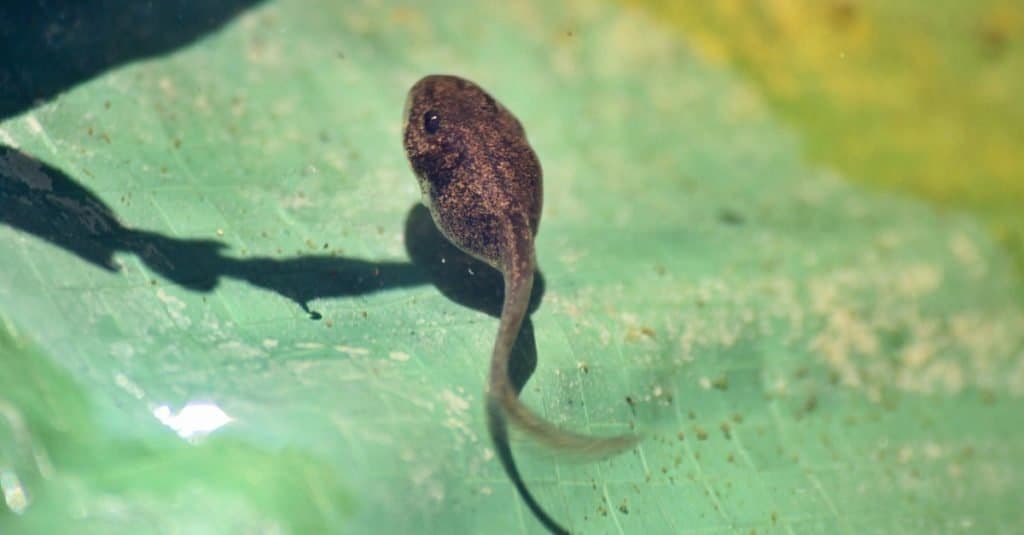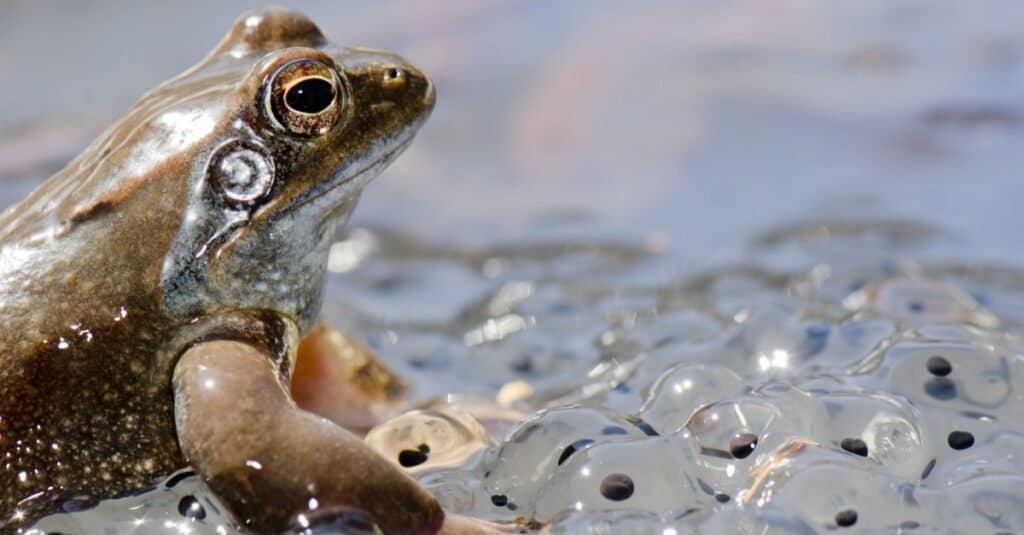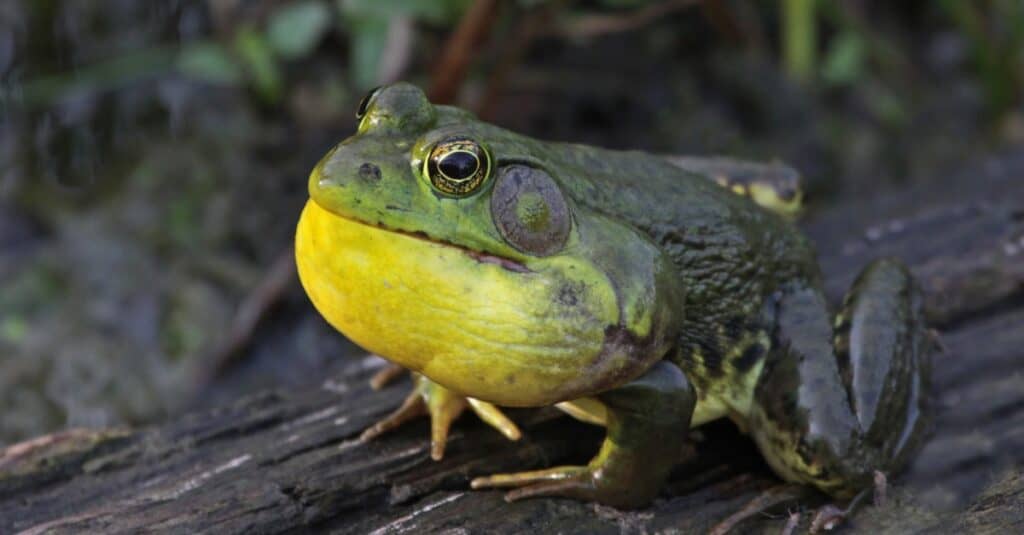Every animal has to reproduce somehow. Whether they give live birth, lay eggs, or perhaps even reproduce asexually, every member of the animal kingdom has to make more of its own species. But, you might ask, what about frogs? Do frogs lay eggs, and if so, how does their life cycle work?
Follow along as we explore the unique ways frogs produce their young. We’ll explore if and why they lay eggs, how the process works from start to finish, and why it’s so fascinating. Frogs are an incredibly diverse group of animals, so their methods of reproduction vary significantly from species to species!
Do All Frogs Lay Eggs?

Most frogs hatch from eggs and start life as fully aquatic tadpoles.
©iStock.com/Suwatwongkham
Like most amphibians, nearly all species of frogs and toads lay eggs. They fertilize their eggs and raise their young in various different ways depending on their species. Most commonly, female frogs lay their eggs in a warm, wet environment, and the male frogs fertilize them with their sperm externally. However, a small number of species engage in internal fertilization.
Female frogs are capable of laying hundreds to even thousands of eggs in a single clutch! This is a necessary adaptation for their survival since frogs have an endless supply of predators that love to eat them and their eggs.
Every spring, frogs and toads will gather with other members of their species to find mates and reproduce. They can locate one another through a series of calls and courtship behaviors. If the frogs are lucky, at least a small percentage of the eggs will end up hatching into tadpoles.
Notably, frog eggs lack protective shells and are quite small and fragile. Female frogs usually lay them in water to keep them moist after a male has fertilized them. Vernal pools are an especially common location for frogs to lay eggs; these are temporary wetlands formed in the springtime by heavy seasonal rains.
Depending on the weather and water temperature, frog eggs take anywhere from a few days to three weeks to hatch. Most frogs begin life as fully aquatic tadpoles. However, they begin their metamorphosis into frogs pretty quickly!
Within only about two to three months’ time, the tadpoles develop lungs and limbs and grow exponentially in size. Once they reach sexual maturity, it’s time to start the mating process all over again!
But external fertilization isn’t the only way frogs reproduce! This brings us to…
Do Any Frogs Give Live Birth?

Most frogs and toads lay eggs, but a select few species give live birth to either tadpoles or fully-formed froglets.
©greggnormal/Shutterstock.com
Biologists have long believed that nearly all species of frogs lay eggs rather than give live birth. Notably, there are 13 species in the Nectophrynoides genus that undergo internal fertilization and give birth to miniature frogs, or froglets.
However, only one species gives live birth to tadpoles! In 2015, researchers discovered a species of fanged frog, Limnonectes larvaepartus, in Indonesia’s rainforests. It is the only frog species that uses internal fertilization to give birth to live tadpoles.
Internal fertilization is most common in mammals and birds, though many reptiles and amphibians use it, too! Essentially, the way it works is a female animal’s egg or eggs get fertilized via sexual reproduction while the eggs are still inside the female’s body.
Once a male releases its sperm, the sperm fertilizes the female’s egg(s). The egg(s) then develop inside the female’s body until the animal either gives live birth or lays the egg(s). If she lays eggs, as most frogs do, the eggs usually have to develop further outside of her body until they hatch into tadpoles.
When it comes to frogs like L. larvaepartus, the eggs develop inside the female’s body until they become tadpoles. The female then gives birth to the live tadpoles. A few other species, like those within the Nectophrynoides genus, give birth to fully-formed froglets! This genus includes the smooth forest toad, minute tree toad, and the pseudo forest toad (Note: all toads are technically frogs).
What Are “Gastric-Brooding” Frogs?

Today’s frogs and toads all either lay eggs in water or give live birth, but a few extinct species of
platypus
frogs incubated their eggs in their mouths!
©Marco Maggesi/Shutterstock.com
Amazingly, a few species of frogs used their mouths to incubate their eggs! Although platypus frogs, or gastric-brooding frogs, used external fertilization, they did so in a very unconventional manner. Immediately after their eggs were fertilized as usual, the females would swallow them, where they would develop in their stomachs.
Unfortunately, the only two species within the genus went extinct in the 1980s. However, we still have plenty of information about the unique way they reproduced.
At first, the female platypus frogs would lay their eggs and have them fertilized externally by males, just like most other species of frogs. At that point, though, things get weird–the female would take the eggs into her mouth and swallow them whole.
Instead of being digested, the eggs would secrete a protective mucus to keep them insulated while they developed inside their mother’s stomach. Over a period of about 6 weeks, the eggs would grow rapidly, which caused their mother’s stomach to expand. To make more space for her young, she would become less active and stop eating altogether. Her lungs would even deflate significantly, causing her to primarily absorb oxygen through her skin to survive.
Finally, once the eggs finished developing into tadpoles, the female frog would regurgitate them. The rest of the frogs’ life cycle was pretty standard–the tadpoles grew into froglets which grew into frogs.
Although researchers are still trying to find remaining members of these two species in the wild, it is likely that habitat loss, pollution, and diseases have killed off these one-of-a-kind frogs entirely.
Do Frogs Reproduce Sexually or Asexually?

Frogs like this
bullfrog
use a wide range of calls and croaks to attract mates.
©iStock.com/ca2hill
Regardless of whether their eggs are fertilized externally or internally, all frogs must engage in sexual reproduction to further their species. There are no known asexual species of frogs. The males carry sperm, while females carry eggs. During sexual reproduction, the male fertilizes the female’s eggs.
Like we touched on earlier, frogs and toads usually congregate in a moist environment every spring to find mates. Once a male or female frog has found a suitable mate, the two will engage in sexual reproduction. In most species, the male will tightly cling to the female’s body in a process known as amplexus.
During amplexus, the male will either fertilize the female’s eggs internally or externally. If he fertilizes the eggs externally, the male and female will release their sperm and eggs at around the same time. Amplexus and the process of fertilization can last anywhere from a few hours to several days.
Once the eggs are fertilized, they start to develop either inside or outside the female frog’s body. Once the eggs are fully developed into tadpoles or froglets, they either hatch or the female gives live birth to them.
The photo featured at the top of this post is © Marco Maggesi/Shutterstock.com
Thank you for reading! Have some feedback for us? Contact the AZ Animals editorial team.






